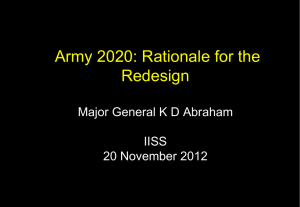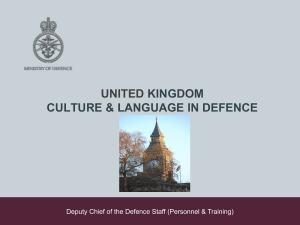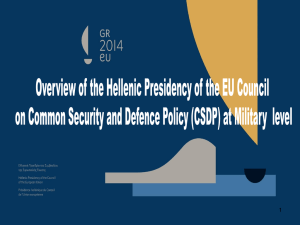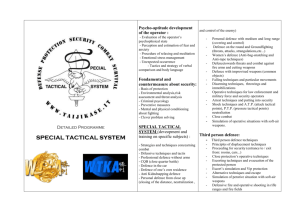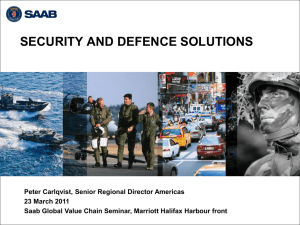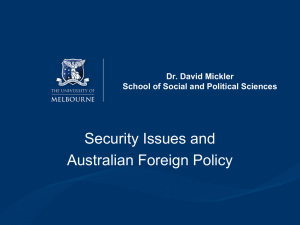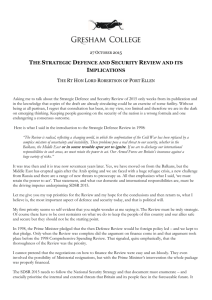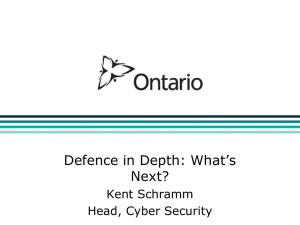National Security Strategy
advertisement
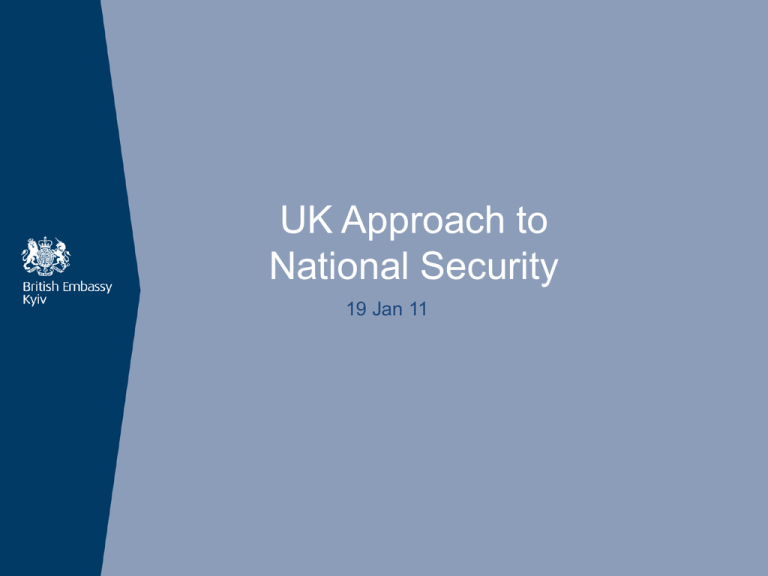
UK Approach to National Security 19 Jan 11 Content > Our approach > National Security Strategy > Strategic Defence and Security Review SDSR Approach > > > > > Defence as part of National Security Afghanistan Trident Value for Money Study Defence Reform Unit Regular Reviews National Security Strategy > > > > > Strategic Context Britain’s Distinctive Role National Security Risk Assessment Adaptable Britain National Security Tasks & Planning Guidelines National Security Strategy > Strategic Context – – – – – – Terrorism - international and NI-related Changing character of conflict Increasingly multi-polar and interconnected Scientific and technological innovation Social and demographic trends Climate change and natural resources National Security Strategy > Britain’s Distinctive Role – – – – – Connected and at the heart of many global networks Role in international affairs Enlightened national self-interest Openness exposes us to risks and opportunities Our response - 2 strategic objectives: • A secure and resilient UK • Shaping a stable world National Security Strategy National Security Risk Assessment – – – – Domestic and overseas; 5 and 20 years Likelihood and impact Vulnerability Tier 1 risks: • • • • Cyber International military crisis International terrorism Major accident or natural hazard -- Impact > Likelihood National Security Strategy > Adaptable Britain – – – – Respond to highest priority risks Respond to low probability but very high impact risks Focus on upstream activity Retain a broad spectrum of security and defence capabilities – Strengthen relationships with key allies – Coordinate and integrate whole of Government response National Security Strategy > National Security Tasks & Planning Guidelines – Identify and monitor risks and opportunities; – Tackle the causes of instability; – Exert influence; – Enforce domestic law and strengthen international norms; – Protect the UK and our interests at home, at our border, and internationally; – Help resolve conflicts and contribute to stability. Where necessary, intervene overseas; – Provide resilience; – Work in alliances and partnerships. SDSR > > > > > > Process Principles Military Tasks Planning Assumptions Force Structure Decisions SDSR Process May Jun Jul Aug Sep Oct Nov Phase 1 - Policy Baseline Phase Policy2 and - Policy Capability and Policy and Capability Studies Capability Studies Studies Phase 3 - Force Testing Phase 4 Synthesis and Costing Phase 5 Decision and Presentation Publication Phase 6 - Implementation Dec SDSR Wider Process Feb 10 mid-08 Global Strategic Trends Feb 09 Future Character of Conflict Jul 09 Feb 10 Feb 10 Green Paper May Jun Jul Aug Sep Oct Nov Phase 1 - Policy Baseline Policy and Capability Policy Capability Phase 2and - Policy and Capability Studies Studies Studies Phase 3 - Force Testing Phase 4 Synthesis and Costing Phase 5 - Decision and Presentation Publication Phase 6 - Implementation Dec Principles > > > > Use of Armed Forces National interest Upstream activity Flexibility Military Tasks > > > > > > Providing strategic intelligence Providing nuclear deterrence Defending the UK and its Overseas Territories Supporting civil emergency organisations in times of crisis Providing a Defence contribution to UK influence Defending our interests by projecting power strategically and through expeditionary interventions > Providing security for stabilisation Developing the Policy Response Matching Resource to Aspiration Increasing Levels of Ambition Homeland Influence Intervention Stabilisation Policy Choices Prioritise Capabilities and shape the force structure to achieve affordability Defence Planning Assumptions The Armed Forces in the future will be sized and shaped to conduct: • an enduring stabilisation operation at around brigade level (up to 6,500 personnel) with maritime and air support as required, while also conducting: • one non-enduring complex intervention (up to 2,000 personnel), and • one non-enduring simple intervention (up to 1,000 personnel); OR alternatively: • three non-enduring operations if we were not already engaged in an enduring operation; OR: • for a limited time, and with sufficient warning, committing all our effort to a one-off intervention of up to three brigades, with maritime and air support (around 30,000, two-thirds of the force deployed to Iraq in 2003). Future Force 2020 Royal Navy > > > > Maritime defence of the UK and Overseas Territories Nuclear Continuous at Sea Deterrence (CASD) Credible and capable presence in priority regions Strike – carrier strike and submarine (TLAM) Future Force 2020 > Single operational carrier; 2nd at extended readiness > 4 Vanguard SSBN and 7 Astute SSN submarines > 19 Destroyers/Frigates > 14 MCMV plus logistic support and RORO ferries > 3 Commando Brigade and Commando Helicopter Force Merlins > c30,000 by 2015; 29,000 by 2020 Royal Navy Reductions > Decommission HMS Ark Royal > Decommission HMS Illustrious > Decommission 4 frigates and a Bay-class amphibious support ship > Place an amphibious landing ship (HMS Albion or Bulwark) at extended readiness Army > Standing commitments eg bomb disposal and Falklands > Light specialist forces for short interventions > Multi-role forces for more complex interventions or enduring stabilisation operations > The ability to command coalitions Future Force 2020 > 5 x multi-role brigades and 16 Air Assault Brigade > Approx 1/3 less heavy armour; but buying FRES Specialist and Utility Variants > “Best Effort” deployment of 3 brigades > c95,000 by 2015; 94,000 by 2020 Army Reductions > Challenger 2 tanks by around 40% > AS90 heavy artillery by around 35% > One deployable brigade (as we restructure to 5 multi-role brigades) > Significantly reduce non-deployable regional command structure > Rationalise deployable headquarters Royal Air Force > > > > Air defence of the UK, Falklands and deployed forces Credible and capable combat air presence Expeditionary combat air incl strategic and tactical airlift ISTAR and RAF Regiment ground units Future Force 2020 > Typhoon and JSF (Carrier Variant - jointly operated by RN & RAF) > C17, A400M, Airbus A330 transport/tanker > Chinook, Puma, Merlin > E3D Sentry, Rivet Joint, UAVs > c33,000 by 2015; 31,500 by 2020 Royal Air Force Reductions > Remove Joint Force Harrier (RN/RAF) in 2011 > Do not bring the Nimrod MRA4 into service > Reduce VC-10 to refuelling role, and aim to withdraw by 2013 > Remove 3 variants of Tristar from 2013 > Withdraw C130J by 2022 > Withdraw Sentinel once it is no longer required in Afghanistan Strategic Nuclear Deterrent > Commitment to continuous at sea submarine-based deterrent 1st new submarine in 2028; decision needed 2016 8 missile tubes (vice 12) 40 warheads per submarine (vice 48) No more than 180 warheads (vice 225); decision on replacement needed 2019 > £3 Bn cost reduction over 10 years > > > > Special Forces > Contribute to a wide range of intervention and stabilisation operations, as well as other commitments > Maintain regular SF front line units > Significantly enhance support capabilities Cyber > New UK Defence Cyber Operations Group – Cyber operations will be conducted in parallel with more conventional actions in the maritime, land and air domains – Mainstream cyber throughout Defence activities – A cadre of experts to secure our own networks and develop new capabilities – Integrated planning, training and exercises – Close relationships across Government, with Allies and with industry Civil Service > Decrease by 25,000 to 60,000 by 2015 – Natural turnover – Limited external recruitment – Early release programme – Consultation with Trades Unions Other > Armed Forces Covenant > Defence Estate Alliances & Partnerships Alliances & Partnerships > New models of bilateral cooperation: – Greater reliance on capability, role sharing and equipment collaboration with close Allies – Reinforced relationship with US – Intensified cooperation with France – Greater cooperation with regional partners to shared security concerns > Enhance effectiveness of multilateral cooperation: – UN - improve effectiveness, conflict prevention focus, coordination with NATO/EU and cyber cooperation; – NATO reform - support Strategic Concept, NATO reform, EU/NATO cooperation – EU - continue enlargement; focus resources on support to (civilian and military) missions. Implementation > > > > > Strategy for Defence Technical Instruction Defence Strategic Direction Defence Industrial Strategy Review of Reserves SDSR Themes > > > > > > Uncertainty: adaptability; readiness Future Conflict: intelligence; precision; mobility Independence: UK; Overseas Territories Multilateralism: risk management Combat Focused: reductions in non-front line areas Affordability Questions
